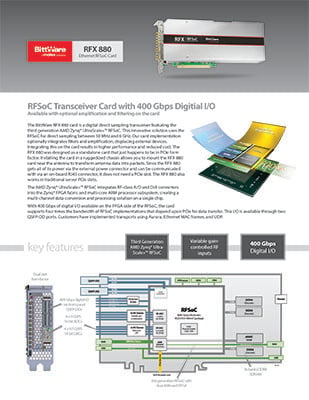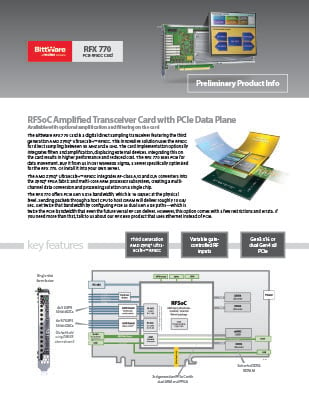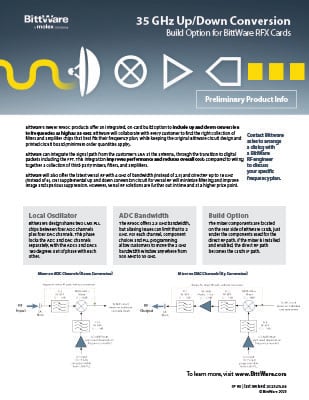RFX 881 + 771
Direct RF Cards with Built-in Up/Down Conversion, Amplification, and Filtering
Analog: 5 GSPS 14-bit ADCs, 9.7 GSPS 14-bit DACs w/Optional Nyquist Zone Filter and Up to 35 GHz Up/Down Conversion
Digital: Up to 400 Gb/s I/O (RFX 881) or PCIe Gen4 x8x8 (RFX 771)
Product Concepts
The RFX 881 and RFX 771 are currently product concepts. Ask us for more details on what’s planned and how we can best match your requirements.
Our Direct RF Products
RFX 880 + RFX 770
4 ADCs + 4 DACs w/400G I/O or PCIe Gen4 x8x8
Optional Integrated Nyquist Filter/Amp
RFX 881 + RFX 771
Up to 8x ADCs or DACs + Digital I/O
Optional Nyquist Filter/Amp, Up/Down Conversion
RFX 881/771 are Product Concepts
WaveBox
1U Enclosure w/ up to 3x RFX 880/881
2U Dual CPU w/up to 2x RFX 770/771

Mix, Amplify, and Digitize All in One
Integrated into a single card you can have up/down mixing (up to 35 GHz), amplifiers and filters for first/second/third Nyquist, and the powerful AMD RFSoC direct RF chip
With RFX, You've got Options
At the heart of RFX products is the revolutionary AMD RFSoC chip, giving you a range of advantages over discreet systems. However, BittWare has leveraged our analog and digital design heritage to bring you more than expected from a typical RF card:
- Direct sampling between 50 MHz and 6 GHz
- Built-in amplifier/filter options to target first, second, or third Nyquist zones on a per channel basis
- Built-in down/up convert up to 35 GHz
- Wideband options to bypass the filtering/amplifiers and mixer per channel
- Up to 400 Gb/s digital I/O with options for PCIe- or QSFP-focused architectures
- Modular build options for our WaveBox RF servers
- Standalone (with QSFP I/O) or as PCIe card
Powered by 3rd Gen AMD Zynq UltraScale+ RFSoC
RFX cards and modules are built around the powerful AMD RFSoC devices. We bring analog signals in, but it’s the direct RF chip approach that packs so much analog and digital functionality that many racks of previous equipment are no longer necessary!
- 通过消除JESD204接口来降低功率
- Smaller physical space
- Programmable (FPGA) logic for diverse requirements and emerging standards
- Built-in ARM processing lets you do more in a standalone deployment
Designed for WaveBox
The RFX 881 and RFX 771 are designed as standalone cards or as PCIe cards in servers. We recommend the WaveBox family of enclosures and servers for the optimum mix of features and the advantage of purchasing an integrated system. Learn more on the WaveBox product page.
Where RFX Fits
At the heart of RFX cards and modules is the AMD RFSoC chip. It combines many of the traditionally discreet RF analog and digital components into a compact, configurable device. Applications including Satcom and test/measurement can benefit from these revolutionary devices.
But with RFX we’ve gone further–bringing to the PCIe form factor optional mixers, amplifiers, and filters. The RFX is configurable too, with up to four inputs/outputs and first/second/third Nyquist filters. Mixer options up to 35 GHz give you up/down conversion all in a single card or module.
Analog Mixing, Amplification, and Filtering Options
On-Card ADCs, DACs, and Mixer
These cards allow you to choose your preference of ADC/DAC channels, with up to eight total in any combination (contact us for pricing and configuration details).
We also have an optional on-card up/down mixer supporting conversions up to 35 GHz. An output option for additional amplification is also available. See the diagrams for details:
Meet the RFX Family
RFX 881
RFX 771
RFSoC
- AMD Zynq UltraScale+ RFSoC
- ZU47DR (G1517 package), core speed grade -2
- Contact BittWare about ZU43DR RFSoC card configuration
Processing Subsystem (PS)
- Application Processing Unit Quad-core Arm Cortex-A53 MPCore at 1.2 GHz
- Real-Time Processing Unit Dual-core Arm Cortex-R5F MPCore at 525 MHz
模拟
Default build using ZU43DR channel count
- 4x 5 GSPS 14-bit ADCs
- Wideband build option -1 to -28 dB gain from 50 MHz to 6 GHz with a 6 GHz LPF
- 1st Nyquist (L-Band) build option provides +22 to -27 dB on all 4 channels, constrained between 500 MHz and 2.5 GHz by filters FL1 and FL2
- 2nd and 3rd Nyquist filters are also available on amplified channels as a special order
- Max input power 0 dBm on the amplified version and +15 dBm on the wideband
- 4x 9.7 GSPS 14-bit DACs
- Range of +3 to -24 dBm (high power end of those ranges is a function of frequency)
- With the amplifier, +20 to -24 dBm
- Constrained by a 4.8 GHz LPF
- Balun used in both ADC and DAC channels begins its frequency roll-off at 8 GHz
- 可编程时钟
- 外部参考和触发器
- Push-on SMPM connectors with optional SMA pigtails
External digital interface
- Up to 400 Gb/s available via front panel 2x QSFP-DD
- AMD Hard IP 支持双 100GbE
RFSoC
- AMD Zynq UltraScale+ RFSoC
- ZU47DR (G1517 package), core speed grade -2
- Contact BittWare about ZU43DR RFSoC card configuration
Processing Subsystem (PS)
- Application Processing Unit Quad-core Arm Cortex-A53 MPCore at 1.2 GHz
- Real-Time Processing Unit Dual-core Arm Cortex-R5F MPCore at 525 MHz
模拟
Default build using ZU43DR channel count
- 4x 5 GSPS 14-bit ADCs
- Wideband build option -1 to -28 dB gain from 50 MHz to 6 GHz with a 6 GHz LPF
- 1st Nyquist (L-Band) build option provides +22 to -27 dB on all 4 channels, constrained between 500 MHz and 2.5 GHz by filters FL1 and FL2
- 2nd and 3rd Nyquist filters are also available on amplified channels as a special order
- Max input power 0 dBm on the amplified version and +15 dBm on the wideband
- 4x 9.7 GSPS 14-bit DACs
- Range of +3 to -24 dBm (high power end of those ranges is a function of frequency)
- With the amplifier, +20 to -24 dBm
- Constrained by a 4.8 GHz LPF
- Balun used in both ADC and DAC channels begins its frequency roll-off at 8 GHz
- 可编程时钟
- 外部参考和触发器
- Push-on SMPM connectors with optional SMA pigtails
主机接口
- x16 Gen3 or bifurcated dual x8 Gen4 interfaces direct to PL
(dual PCIe Gen 4 x8 with restrictions and errata)
35 GHz Up/Down Conversion
对价格或更多信息感兴趣?
我们的技术销售团队随时准备提供可用性和配置信息,或回答您的技术问题。
"*"表示必填项目


